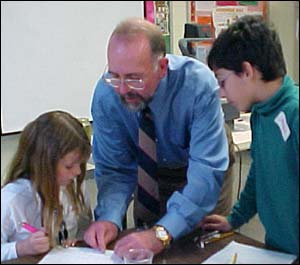'The Student as Scientist' the Theme of New Science Textbook

KEENE, N.H. 5/2/05 - There is a severe shortage of science and math teachers nationally and in New Hampshire. Keene State is doing its part to fill this void, by not only training future teachers in science concepts, but also in the latest approaches to teaching science.
How science is taught, says Russell Harkay, professor of physics, affects whether students pursue further studies or careers in the area. “We hope that elementary and middle school education majors take with them a way of teaching science that they feel comfortable with and enthusiastic about,” he explains.
In the second edition of his textbook, Phenomenal Physics: A Guided Inquiry Approach, which was published this spring, Dr. Harkay takes the approach of “the student as scientist.” Throughout the book, which provides science concepts and lessons for teachers of grades K-college first year, Dr. Harkay uses “guided inquiry” as an instructional theme. Using this approach, he says, the student actively makes discoveries and trying to solve science problems and, in doing so, learning scientific concepts and methods.
The book is based in part on Dr. Harkay’s popular Physics 100 course, which he developed and taught to large numbers of students over a number of years in the 80’s and 90’s. Some KSC professors have started changing the way they teach science, from a lecture-based format to guided inquiry. “The more time that students are given to studying using this approach, the better they will learn the methods of science,” he says. “We want students to be skeptical, to ask questions, to use models and know the limitations of models, to figure out for themselves what’s good science and what’s bad science.”
Dr. Harkay, who will use the book to teach his Physics 100 and 201 classes, believes that other educators will find it a useful teaching tool. He has already had several inquiries from colleges and from a home school consortium.
In his book, Dr. Harkay provides lessons on motion and dynamics, forces, pressure and buoyancy, Newton’s Laws, sound, light, temperature and heat, electricity and magnetism, modern physics, and other concepts. Many of the hands-on exercises, supplemented by text, can be done using household supplies, although a few purposely integrate technology. The fall printing will contain many conceptual homework problems, currently being edited and integrated into the text.
For more information, contact Russ Harkay at 358-2588.





